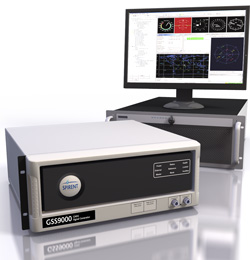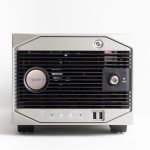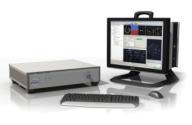 Spirent GSS9000
Spirent GSS9000Spirent has launched a new generation of multi-frequency, multi-GNSS RF constellation simulator — the Spirent GSS9000.
The GSS9000 supports an extensive range of constellation configurations, from GPS L1 through to multi-GNSS, multi-frequency systems, including classified/restricted signals. Configurations are available that support multi-antennas and multi-vehicles, for example differential GNSS, attitude determination, interference/jamming and spoofing, and controlled reception pattern antenna (CRPA) testing.
Spirent has launched a new generation of multi-frequency, multi-GNSS RF constellation simulator — the Spirent GSS9000.
The GSS9000 supports an extensive range of constellation configurations, from GPS L1 through to multi-GNSS, multi-frequency systems, including classified/restricted signals. Configurations are available that support multi-antennas and multi-vehicles, for example differential GNSS, attitude determination, interference/jamming and spoofing, and controlled reception pattern antenna (CRPA) testing.
According to the UK–based company, the GSS9000 generates all carriers, ranging codes and data streams for the GPS, GLONASS, Galileo and BeiDou GNSS systems, plus SBAS, QZSS, IRNSS and CAPS regional/augmentation systems. Additionally, data/ messages for RTCM differential, GBAS/LAAS and A-GNSS are provided. Spirent says that the GSS9000 can generate classified/restricted GPS and Galileo signals — for authorized users — and reportedly is the only GNSS simulator to support Galileo PRS at the time of writing.
Spirent identifies some of the new simulator’s key attributes as including a high System Iteration Rate (SIR), highly flexible configurations selectable via a “cabinet” of feature keys, portability of Spirent SimGEN scenarios, in-field upgradeability of principal GNSS functionality and capability, on-the-fly reconfiguration of constellation and signal configurations, all GNSS constellation types and all frequencies brought into a single chassis, backward compatibility with legacy scenarios enabling seamless transition from existing Spirent platforms, fully future-proofed for all advances in GNSS technology,
The Spirent GSS9000 is controlled by Spirent’s GNSS simulation software, SimGEN, which enables users to control test scenario generation, including multiple GNSS and regional satellite constellations, signal propagation, multipath and obscuration effects, GNSS/inertial operation, antenna patterns, vehicle trajectory, and a range of error models.
The GSS9000 supports all current and many future GNSS systems and signals:
• U.S. GPS L1, L2, L5 (including classified signals, for authorized users)
• Europe’s Galileo E1, E5, E6 (including classified signals, for authorised users)
• Russia’s GLONASS L1, L2
• China’s BeiDou-2 B1, B2
• Various satellite-based augmentations systems (SBAS: WAAS, EGNOS, MSAS), L1 and L5
• Japan’s Quasi-Zenith Satellite System, L1, L2, L5
• Indian Regional Navigation Satellite System
• Chinese Area Positioning System (CAPS)





